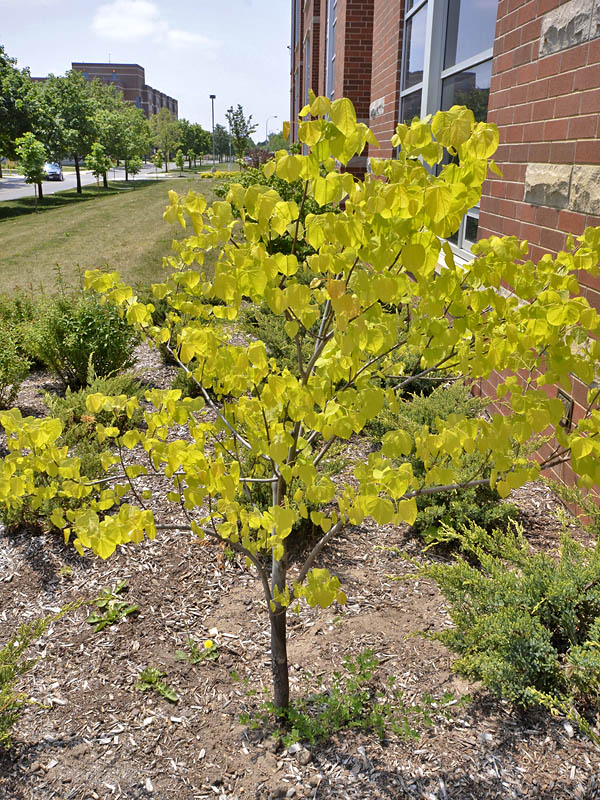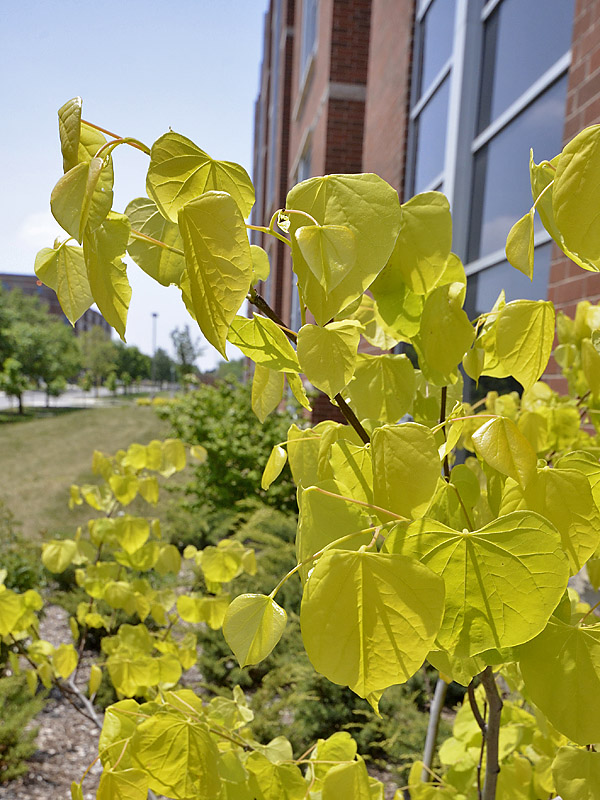
Woody > Cercis > Cercis canadensis > Cercis canadensis 'Hearts of Gold'
Cercis canadensis
'Hearts of Gold'
Hearts of Gold Redbud
Origin: `Hearts of Gold` is the first known gold foliage red bud in North America developed by Jon Roethling of North Carolina and introduced in August of 2008. The word Cercis is a derivative of the Greek word, kerkis, a weaver's shuttle, which Theophrastus likened the tree's flattened woody fruits to.

"
It is hard to forget this trees beautiful foliage with the colour and shape of the leaf matching the name perfectly: heart-shaped leaves being a brilliant yellow-gold. Cercis canadensis `Hearts of Gold` is a beautiful, small, but short-lived tree with a mature height of 6 m, hence making it suitable for most landscapes. It can withstand many different soil types and produces its best foliage colour in full sun. The leaf colour changes from pink-purple upon emergence in the spring then turning quickly to the yellow-gold and finally to a light green in summer. This is typically a multi-stemmed tree but pruning of all but one stem will give it that ornamental shape that fits perfectly into most landscapes.
Michael Pascoe, NDP., ODH., CLT., MSc. (Plant Conservation)
"
| Family |
| Fabaceae |
| Genus |
| Cercis |
| Species |
| canadensis |
| Cultivar |
| 'Hearts of Gold' |
| Category |
| Woody |
| Type |
| Tree (deciduous) |
| Pronunciation |
| USDA Hardiness Zone |
| 4-9 |
| Canadian Hardiness Zone |
| 6 |
| Temperature (°C) |
| -18 - (-23) |
| Temperature (°F) |
| -10 - (-20) |
| Height |
| 6 m |
| Spread |
| 4-6 m |
| General Description |
| `Hearts of Gold` has a wide range of foliage colour with the new leaves emerging a pink-purple tone in the spring and then quickly progressing to a yellow, almost golden colour then later changing to apple green at the onset of summer. The foliage emulates its cultivar name perfectly, being a beautiful gold, rounded, heart-shape leaf. Additionally it produces small clusters of purple, pea-like flowers along its branches prior to leaf emergence. |
| Landscape |
| Cercis canadensis 'Hearts of Gold' is one of the first known gold foliaged cultivars of C. canadensis. 'Hearts of Gold' is principally used as a small tree in landscape settings, with a mature height of 6 m and a spread of 4-6 m. It is hard to forget this trees beautiful foliage with the colour and shape of the leaf matching the name perfectly: heart-shaped leaves being a brilliant yellow-gold. |
| Cultivation |
| Cercis canadensis 'Hearts of Gold' prefers well-drained soils and once established is considered somewhat drought tolerant. Leaf colour is best if the tree is planted in full sun. It can be trained to be a single stem tree but I prefer it as I do all other Cercis species and cultivars as multi-stemmed plant. |
| Shape |
| Upright vase shape, being as broad as its height. |
| Growth |
| Medium |
| ID Characteristic |
| The key identification characteristic are its leaves: emerging purple-pink and then turning a yellow-gold and fading to apple green. Leaves are heart-shaped with rounded apices. Small pea-like blooms typical to most Cercis species and cultivars outline the branches in spring prior to leaf emergence. |
| Pests |
| It may suffer from Verticillium wilt and Botryosphaeria canker. |
| Habitat |
| Horticultural origin. |
| Bark/Stem Description |
| The bark is light grey in colour, with small, linear, plates. |
| Flower/Leaf Bud Description |
| Absent terminal bud, small, lateral buds being a a balckish-red in colour and about 3-5 mm long. |
| Leaf Description |
| The simple, entire, leaves are held in an alternate arrangement, are ovate-orbiculate in shape shape and are approximately 4-6 cm long and 5-10 cm across. Leaf venation is palmate, reticulate brachidodrome and pinnate. Leaves emerge purple-pink in the spring, changing to yellow gold and then to apple green at the onset of summer. With a 4-6 cm petiole leaves tend to weep slightly from the branches. |
| Flower Description |
| Perfect, small purple-pink, pea shaped flowers, 2.5 cm long, blooming in late May-June. |
| Fruit Description |
| Common to most redbuds are brown-grey coloured pods being quite thin and from 5-10 cm long, often persisting on the branches through to the following season. |
| Colour Description |
| `Hearts of Gold` has a wide range of foliage colour with the new leaves emerging a pink-purple tone in the spring and then quickly progressing to a yellow, almost golden colour then later changing to apple green at the onset of summer. The foliage emulates its cultivar name perfectly, being a beautiful gold, rounded, heart-shape leaf. Additionally it produces small clusters of purple, pea-like flowers along its branches prior to leaf emergence. The bark is light grey in colour. |
| Texture Description |
| This is a course textured plant that changes to a medium texture in the winter time due to leaf drop. |
| Notable Specimens |
| The Gardens of Fanshawe College, London, Ontario, Canada. |
| Propagation |
| 'T' budding provides the best, but limited results (50% success rates) in summer on C. canadensis rootstock. Rooting from stem cuttings is very difficult with the potential for tissue culture showing some promise. |

